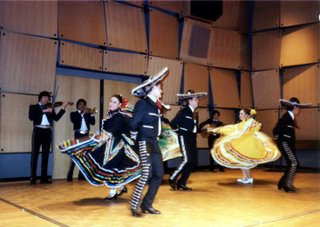Mariachis povided music as the Charro and the Tapatia danced the sones jaliscienses

The other time when the Charro would wear his traje de gala was on Sunday mornings. After the religious services in the the town, he would gather with the rest of the townspeople in the town square (i.e., la plaza) near the gazebo (i.e., el kiosko). It would be here that the mariachi music would be playing the lively and rhythmic songs of Jalisco (sones jaliscienses). The Charro would invite one of the pretty senoritas to dance -- although she would be under the watchful eye of her chaperone (i.e., la alcahueta). Since it was not permitted for a young lady to speak to strangers, it was only while they were dancing that the Charro would converse -- and even flirt-- with the senorita, trying to sneak a kiss of affection during the moves of the dances. And, at the end of the dance, the Charro would show his bravery, as he would cover both his and her head with his hat (sombrero) and sneak a small kiss from the senorita tapatia.
However, today, in addition to the traditional traje de charro (traje de gala), more modern Mariachi bands wear derivatives of this outfit. For instance, from the purist point of view, the code of the Charro (el codigo del charro) dictates that the authentic outfit be plain; that the single solid color be black; and that the silver have the design of the Aztec calendar. In no way would adornments, other designs or other colors be allowed.
However, as time went on, not only were different colors and different designs of the silver used, but also even different outfits other than the original traje de charro. Some of these are known to be used by other foremen and ranch hands of the hacienda -- such as the caporal. And in some countries (other than Mexico) which have Mariachis that entertain in clubs and restaurants (e.g., Costa Rica and Venezuela), the musicians have taken quite a license to make the costumes more colorful, attractive, and even flashy. These modern musicians attempt to gain the eye of the tourists through popularity -- but it is a huge departure from the official code of the Charro and the original traje de charro - traje de gala.

<< Home